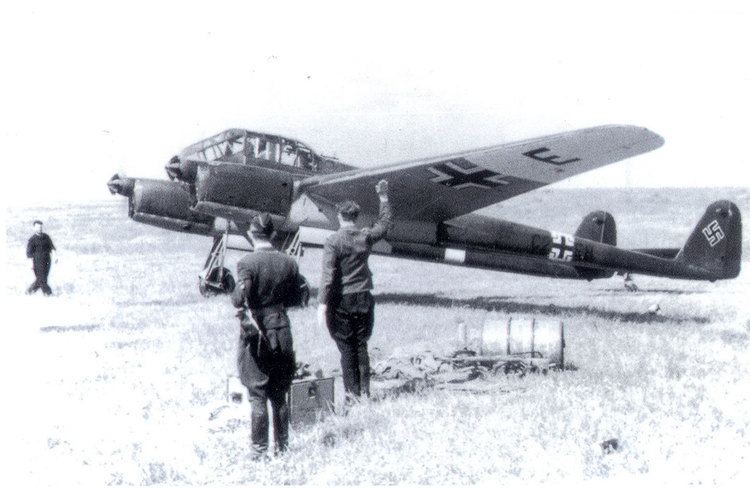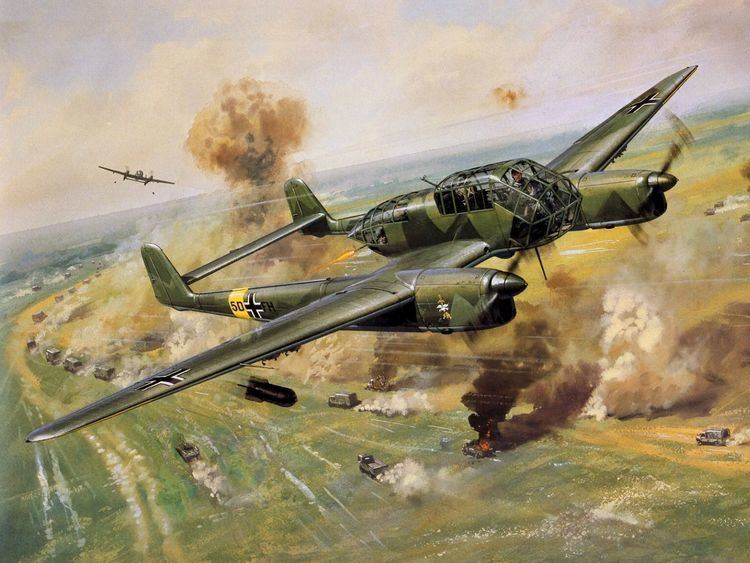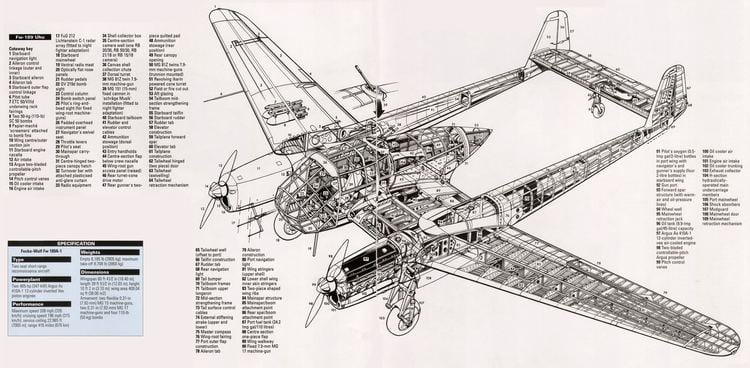Wingspan 18 m Retired 1945 | Length 12 m First flight July 1938 | |
 | ||
Focke wulf fw 189 uhu reconnaissance aircraft in action in ww2 on the eastern front
The Focke-Wulf Fw 189 Uhu ("Eagle Owl") was a German twin-engine, twin-boom, three-seat tactical reconnaissance and army cooperation aircraft. It first flew in 1938 (Fw 189 V1), entered service in 1940 and was produced until mid-1944. It should not be confused with the Heinkel He 219 night fighter also named Uhu.
Contents
- Focke wulf fw 189 uhu reconnaissance aircraft in action in ww2 on the eastern front
- Il2 focke wulf fw 189
- Design and development
- Operational history
- Variants
- Operators
- Surviving aircraft
- Specifications Fw 189 A 1
- References

In addition, Focke-Wulf used this airframe in response to a tender request by the RLM for a dedicated ground attack airplane, and later submitted an armored version for trials. However, the Henschel Hs 129 was selected instead.

Il2 focke wulf fw 189
Design and development

In 1937, the German Ministry of Aviation issued a specification for a short-range, three-seat reconnaissance aircraft with a good all-round view to support the German army in the field, replacing the Henschel Hs 126, which had just entered service. A power of about 850–900 hp (630–670 kW) was specified. The specification was issued to Arado and Focke-Wulf. Arado's design, the Ar 198, which was initially the preferred option, was a relatively conventional single-engined high-wing monoplane with a glazed gondola under the fuselage. Focke-Wulf's chief designer Kurt Tank's design, the Fw 189, was a twin-boom design, powered by two Argus As 410 engines rather than the expected single engine and a central crew gondola designed with a heavily glazed and framed "stepless" cockpit forward section, which used no separate windscreen panels for the pilot (as with many German medium bombers), while Blohm & Voss proposed as a private venture something even more radical: chief designer Dr. Richard Vogt's unique asymmetric BV 141. Orders were placed for three prototypes each of the Arado and Focke-Wulf designs in April 1937.

The Fw 189 was produced in large numbers, at the Focke-Wulf factory in Bremen, at the Bordeaux-Merignac aircraft factory (Avions Marcel Bloch's factory, which became Dassault Aviation after the war) in occupied France, then in the Aero Vodochody aircraft factory in Prague, occupied Czechoslovakia. Total production was 864 aircraft of all variants.
Operational history

Called the Fliegende Auge ("Flying Eye") of the German Army, the Fw 189 was used extensively on the Eastern Front with great success. It was nicknamed "Rama" ("frame" in both the Russian and Ukrainian languages) by Soviet forces, referring to its distinctive tail boom and stabilizer shapes giving it the characteristic quadrangular appearance. Despite its low speed and fragile looks, the Fw 189's manoeuvrability made it a difficult target for attacking Soviet fighters. When attacked, the Fw 189 was often able to out-turn attacking fighters by simply flying in a tight circle into which enemy fighters could not follow.
Variants

The main production model was the Fw 189A reconnaissance plane, built mostly in two variants, the A-1 and A-2. Unless otherwise stated all aircraft were powered by two Argus As 410 engines of 465 PS (459 hp, 342 kW).
The Fw 189B was a five-seat training aircraft; only 13 were built.
The Fw 189C was conceived as a heavily armoured ground-attack, close-support variant, in competition with the Henschel Hs 129. But its two prototypes (V1b and V6) were not satisfactory, and it was not produced.
Operators
Surviving aircraft
One Fw 189 survives today. Its story starts on May 4, 1943 when Fw 189 V7+IH (Werk Nr. 2100), of 1./Nahaufklärungsgruppe 10, with V7 originally the Geschwaderkennung code for Heeres-Aufklärungsgruppe 32 based at Pontsalenjoki (due east of Kuusamo, and within the south-central area of modern Russia's Republic of Karelia) took off on a mission to photograph the Loukhi-3 airbase from an altitude of 6,000 m (20,000 ft), then to continue north along the Murmansk-Leningrad railway. Approximately 31 minutes after taking off, V7+IH was attacked by Lend-Lease-acquired Soviet Hawker Hurricane fighters. The aircraft dived to escape the fighters, but owing to damage already suffered, could not pull out in time, and it struck the treetops. The tail was torn off, and the crew nacelle left hanging upside down within the trees. The pilot, Lothar Mothes, survived but one crewman was killed in the crash and the third died from blood loss as a result of a severed leg. Incredibly, Mothes was able to survive two weeks in sub-zero temperatures, evading Soviet patrols while eating bark and grubs as he walked back to his base. Mothes spent the next nine months in a hospital recovering from severe frostbite before returning to the front line, eventually to fly another 100 missions.
In 1991, the wreckage of V7+IH was found in the Russian forest where it had remained for 48 years. The aircraft was purchased by a group of British aircraft enthusiasts and was shipped to the UK, arriving in the town of Worthing, West Sussex in March 1992. The Focke Wulf 189 Restoration Society was formed to restore the aircraft to flying condition. Her former pilot, Lothar Mothes, met up again with his aircraft at the 1996 Biggin Hill Airshow.
It was reported that this aircraft was acquired by Paul Allen’s Flying Heritage Collection however its current state is not publicly known.
Specifications (Fw 189 A-1)
General characteristics
Performance
Armament
